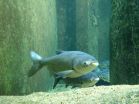(Press-News.org) Researchers at the MIT Media Lab are developing a new wearable device that turns the user's thumbnail into a miniature wireless track pad.
They envision that the technology could let users control wireless devices when their hands are full -- answering the phone while cooking, for instance. It could also augment other interfaces, allowing someone texting on a cellphone, say, to toggle between symbol sets without interrupting his or her typing. Finally, it could enable subtle communication in circumstances that require it, such as sending a quick text to a child while attending an important meeting.
The researchers describe a prototype of the device in a paper they're presenting at the Association for Computing Machinery's Computer-Human Interaction conference in Seoul, South Korea.
According to Cindy Hsin-Liu Kao, an MIT graduate student in media arts and sciences and lead author on the new paper, the device was inspired by the colorful stickers that some women apply to their nails. "It's a cosmetic product, popular in Asian countries," says Kao, who is Taiwanese. "When I came here, I was looking for them, but I couldn't find them, so I'd have my family mail them to me."
Indeed, the researchers envision that a commercial version of their device would have a detachable membrane on its surface, so that users could coordinate surface patterns with their outfits. To that end, they used capacitive sensing -- the same kind of sensing the iPhone's touch screen relies on -- to register touch, since it can tolerate a thin, nonactive layer between the user's finger and the underlying sensors.
As the site for a wearable input device, however, the thumbnail has other advantages: It's a hard surface with no nerve endings, so a device affixed to it wouldn't impair movement or cause discomfort. And it's easily accessed by the other fingers -- even when the user is holding something in his or her hand.
"It's very unobtrusive," Kao explains. "When I put this on, it becomes part of my body. I have the power to take it off, so it still gives you control over it. But it allows this very close connection to your body."
To build their prototype, the researchers needed to find a way to pack capacitive sensors, a battery, and three separate chips -- a microcontroller, a Bluetooth radio chip, and a capacitive-sensing chip -- into a space no larger than a thumbnail. "The hardest part was probably the antenna design," says Artem Dementyev, a graduate student in media arts and sciences and the paper's other lead author. "You have to put the antenna far enough away from the chips so that it doesn't interfere with them."
Kao and Dementyev are joined on the paper by their advisors, principal research scientist Chris Schmandt and Joe Paradiso, an associate professor of media arts and sciences. Dementyev and Paradiso concentrated on the circuit design, while Kao and Schmandt concentrated on the software that interprets the signal from the capacitive sensors, filters out the noise, and translates it into movements on screen.
For their initial prototype, the researchers built their sensors by printing copper electrodes on sheets of flexible polyester. That allowed them to experiment with a range of different electrode layouts, but in ongoing experiments, they're using off-the-shelf sheets of electrodes like those found in some track pads.
They've also been in discussion with battery manufacturers -- traveling to China to meet with several of them -- and have identified a technology that they think could yield a battery that fits in the space of a thumbnail but is only half a millimeter thick. A special-purpose chip that combines the functions of the microcontroller, radio, and capacitive sensor would further save space.
At such small scales, however, energy efficiency is at a premium, so the device would have to be deactivated when not actually in use. In the new paper, the researchers also report the results of a usability study that compared different techniques for turning it off and on. They found that requiring surface contact with the operator's finger for just two or three seconds was enough to guard against inadvertent activation and deactivation.
INFORMATION:
Related links
ARCHIVE:
Finger-mounted reading device for the blind
ARCHIVE:
Manual control
Selective breeding of maize over the last century to create hybrids with desirable shoot characteristics and increased yield may have contributed indirectly to the evolution of root systems that are more efficient in acquiring nutrients, such as nitrogen, from the soil, according to researchers.
Their results suggest that future breeding efforts that directly select for positive root traits could lead to yield gains needed to help feed a growing world population, while reducing pollution from excess nitrogen and reducing farmers' fertilizer costs.
About half of the ...
Putnam Valley, NY. (Mar. 16, 2015) - Osteoarthritis (OA), a debilitating and painful degenerative disease, strikes an estimated 14 percent of adults 25 years of age and older, a third of adults age 65 and older in the U.S. alone. Those who suffer from OA may one day have a new and effective cell therapy, thanks to a team of Czech researchers who studied the effectiveness of using an OA patient's own adipose (fat) cells in a unique transplant therapy aimed at reducing the symptoms of this prevalent and difficult to treat condition as well as healing some of the damage caused ...
The likelihood of Asian carp eggs being kept in suspension and hatching in the St. Joseph River in Michigan has been further evaluated using a model that examines a range of multiple flow and water temperature scenarios. Results illustrate the highest percentage of Asian carp eggs at risk of hatching occurs when the streamflow is low and when the water temperature is high. This new study by the University of Illinois and the U.S. Geological Survey (USGS) is published in the Journal of Great Lakes Research.
"In this study, the Fluvial Egg Drift Simulator (FluEgg) model ...
Biological diversity brings beauty and variety to our lives and to the world around us. It also could be the key to keeping ecosystems strong, according to a new University of Minnesota study published April 17 in the journal Science.
The study, led by Yann Hautier a Marie Curie Fellow associated with the College of Biological Sciences at the University of Minnesota and with the University of Oxford, U.K., looked at 28 years' worth of data on plant growth, number of species, ecosystem stability and exposure to changes in nitrogen, carbon dioxide, fire, grazing and water ...
Through a combination of data analysis and numerical modeling work, researchers have found a record of the ancient Moon-forming giant impact observable in stony meteorites. Their work will appear in the April 2015 issue of the Journal Science. The work was done by NASA Solar System Exploration Research Virtual Institute (SSERVI) researchers led by Principal Investigator Bill Bottke of the Institute for the Science of Exploration Targets (ISET) team at the Southwest Research Institute and included Tim Swindle, director of the University of Arizona's Lunar and Planetary Laboratory.
The ...
A skin cell responsible for scarring, and a molecule that inhibits the cell's activity, have been identified by researchers at the Stanford University School of Medicine.
The molecule slowed wound healing in mice but alleviated scarring, the researchers said.
The researchers also found that the cell may play a role in the growth of melanoma and in skin damage caused by radiation. A drug that acts in the same way as the inhibitory molecule is already approved for use in humans as a treatment for type-2 diabetes, so it could potentially move quickly into clinical trials ...
For more than 250 million years, four-limbed land animals known as tetrapods have repeatedly conquered the Earth's oceans. These creatures--such as plesiosaurs, penguins and sea turtles--descended from separate groups of terrestrial vertebrates that convergently evolved to thrive in aquatic environments.
In a new scientific review, a team of Smithsonian scientists synthesized decades of scientific discoveries to illuminate the common and unique patterns driving the extraordinary transitions that whales, dolphins, seals and other species underwent as they moved from land ...
Supermassive black holes, often with masses billions of times that of the Sun, are located at the heart of almost all galaxies in the Universe. These black holes can accrete huge amounts of matter in the form of a surrounding disc. While most of this matter is fed into the black hole, some can escape moments before capture and be flung out into space at close to the speed of light as part of a jet of plasma. How this happens is not well understood, although it is thought that strong magnetic fields, acting very close to the event horizon, play a crucial part in this process, ...
A global study on canine rabies, published today (16 April 2015), has found that 160 people die every single day from the disease. The report is the first study to consider the impact in terms of deaths and the economic costs of rabies across all countries. Even though the disease is preventable, the study says that around 59,000 people die every year of rabies transmitted by dogs.
The multi-author study, by the Global Alliance for Rabies Control's Partners for Rabies Prevention Group, also shows that annual economic losses because of the disease are around 8.6 billion ...
Scientists have discovered a protein that plays a central role in promoting immunity to viruses and cancer, opening the door to new therapies.
Experiments in mice and human cells have shown that the protein promotes the proliferation of cytotoxic T cells, which kill cancer cells and cells infected with viruses. The discovery was unexpected because the new protein had no known function and doesn't resemble any other protein.
Researchers from Imperial College London who led the study are now developing a gene therapy designed to boost the infection-fighting cells, and ...



